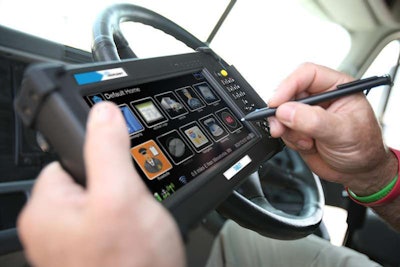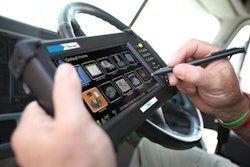 The new electronic logging rule includes provisions intended to prevent driver harassment involving the devices.
The new electronic logging rule includes provisions intended to prevent driver harassment involving the devices.The Federal Motor Carrier Safety Administration announced March 12 a Supplemental Notice of Proposed Rulemaking to mandate electronic logging devices.
The rule’s effective date and publication date in the Federal Register still are unknown, but it’s likely the rule will go into effect in late 2016. The proposal says it will go into effect two years after the final rule is issued, presumably later this year.
The American Trucking Associations welcomed the proposal. The Owner-Operator Independent Drivers Association expressed doubt about its ability to satisfy MAP-21 requirements and said it will closely study the proposed rule.
The rule consists of four parts: (1) The requirement to use ELDs, (2) Protections against driver harassment (3) Hardware specifications for the devices and (4) the hours of service-related supporting documents drivers must continue to carry after the mandate.
Here’s a breakdown of each component:
Mandating ELDs
The mandate will apply to all drivers who are currently required to keep paper records of duty status. Drivers who are required to keep records of duty status in eight or more days out of every 30 days must use an ELD, replacing the 2011 rule’s requirement that drivers who keep records of duty status two or more days out of every seven use a logging device.

Carriers and drivers would not be required to install or use a logging device until two years after the effective date of the final rule. Carriers who used what the agency calls “automatic onboard recording devices” prior to the ELD mandate, however, have two more years on top of that to comply.
Harassment
Driver harassment by way of e-logs was the key factor that caused a court to throw out the last ELD mandate. The new ELD rule includes provisions to prevent driver harassment involving the devices.
According to the rule, the agency says its two “primary focuses” relative to driver harassment were pressures on drivers to exceed hours of service limits and “inappropriate communications that affect drivers’ rest periods.”
Proposed safeguards against harassment in the new rule include expanded drivers’ access to records, explicit wording about carriers harassing drivers, implementing a complaint procedure, stiffening penalties for those who do harass drivers, “edit rights” for drivers, limitations on location tracking, mute functionality for the devices and preserving driver confidentiality in enforcement proceedings.
See an extended story on the rule’s harassment safeguards Friday, March 14.
Hardware specifications
The devices required by the new rule are more technologically advanced than those required by the April 2010 rule, FMCSA says.
The new rule requires ELDs to be integrated with the truck’s engine and to use location information. They also must be tamper-resistant. The devices will track the truck’s movement but can allow for annotations by both drivers and carriers “to explain or correct records,” the rule says.
FMCSA is developing with states software to be able to receive, analyze and display data from ELDs so that roadside officers can use the information, according to the rule.
ELDs, as opposed to their EOBR and AOBRD (electronic onboard recorder and automatic onboard recording device) predecessors, sync with a truck’s engine to capture power status, motion status, miles driven and engine hours, FMCSA says. They also automatically enter changes of duty status, 60-minute intervals while the truck’s moving and engine-on and engine-off instances, according to the rule.
The rule also stipulates that the ELDs “present a graph grid of a driver’s daily duty status changes either” on the units themselves or in printouts.
The rule also stipulates the connectivity methods, which include Bluetooth 2.1, email, USB 2.0 and more.
Supporting documents
Carriers and drivers will still be required to maintain documentation that verifies drivers’ hours of service records. “Supporting documents” can refer to either paper or electronic documents.
Documents verifying driving time would not need to be kept, FMCSA says, but ones that verify periods of drivers’ on-duty not driving time must be maintained.
For every 24-hour period the driver is on duty, carriers must maintain no more than 10 supporting documents from either of these categories (1) bills of lading, itineraries, schedules or other documents that show trip origin and destination, (2) dispatch records, trip records or similar documents (3) expense receipts, (4) electronic mobile communication records sent through fleet management systems or (5) payroll records, settlement sheets or similar documents that show what and how a driver was paid.
***
The Supplement Notice of Proposed Rulemaking follows an FMCSA rule from April 2010 that mandates the use of EOBRs. That entire rule, however, was vacated in August 2011 by a federal court.
The annualized cost of compliance for the new rule will be between $165 and $832 per truck, according to the rule.
The Owner-Operator Independent Drivers Association said it knows of no device that can automatically record a driver’s duty status, which is what OOIDA says Congress required in MAP-21.
“We will examine the proposal in detail to see how the agency has attempted to meet these requirements, especially considering that an important study on the harassment issue is still listed as ‘ongoing’ on the FMCSA website,” says OOIDA’s statement. “Further, the issue of cost to truckers and what specific technical requirements are called for, especially when FMCSA has yet to show any direct safety benefit between ELD/EOBR use and reduced crashes, will be a critical focus of our review of the proposal. This is the first stage in the regulatory process for the agency’s latest attempt to craft a rule on this topic, and OOIDA and small business truckers will certainly be weighing in and providing comments.”
The American Trucking Associations said it “welcomes” the mandate. “ATA supports FMCSA’s efforts to mandate these devices in commercial vehicles as a way to improve safety and compliance in the trucking industry and to level the playing field with thousands for fleets that have already voluntarily moved to this technology,” said ATA President and CEO Bill Graves.
ATA was one a key proponent in pushing for the ELD mandate’s inclusion in the 2012 MAP-21 highway funding act.













